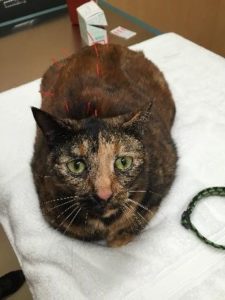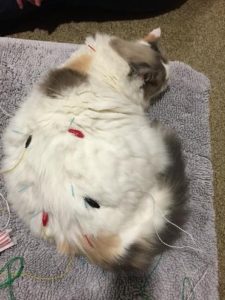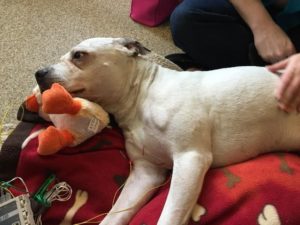Veterinary Acupuncture
 What is acupuncture?
What is acupuncture?
Acupuncture is the insertion of small, sterile needles at specific points in the body. It is used to modulate change in the pain, neurologic and autonomic (fight or flight vs rest and digest) systems, and to a lesser extent the gastrointestinal, endocrine, and immune systems.
Who developed acupuncture?
The first written reference to acupuncture comes from the Han period in China. The National Institutes of Health (NIH) began to study acupuncture, as well as other facets of Chinese medicine, in the 1970s. Veterinarians in Europe began applying the practice to their patients in the 1950s and 1960s. The International Veterinary Acupuncture Society (IVAS) was founded in 1974. The American Veterinary Medical Association (AVMA) first recognized acupuncture in 1996.
What are channels and meridians?
Channels and meridians were first described as means of energy flow through the body. We now realize that the majority of these meridians align with nerves and blood vessels; and that acupuncture points often coincide with major grouping of nerves or vessels, or near emergence of nerves through muscle bellies.
How is an acupuncture needle different from other needles?
An acupuncture needle, depending on the size, is several orders or magnitude smaller than a hypodermic needle that is used for medical procedures. The needles are also solid as opposed to hollow, and are available in coated varieties to reduce pain. They are individually packaged in sterile wrapping.
How does acupuncture work?
There are five major mechanisms of acupuncture: local effects, segmental effect, extrasegmental effect, central pain regulation effects, and relief of myofascial trigger points.
Local effects include stimulation of nerve fibers of the skin and muscle (axon reflex) and blood vessel dilation. A feeling of numbness and heaviness is reported by people receiving acupuncture.
Segmental (regional) pain relief is achieved via inhibition of the pain pathway at the level of the spinal cord and regulation of regional autonomic tone . Segmental activity allows us to modulate pain by placing needles at points in the same region of the painful area.
Extrasegmental (whole body) pain relief is achieved by regulation of the pain and autonomic systems and release of natural pain relievers by the brain and spinal cord. A general sense of well-being is induced via release of serotonin and oxytocin. Pain inhibition is increased along the spinal cord.
Acupuncture induces central regulation of pain via modification of the limbic (emotional) system. Deep sleep is often noted after an acupuncture treatment.
Acupuncture can also be used to release myofascial trigger points, which are hyperirritable taut bands within a muscle belly. Trigger points are often developed as compensation for musculoskeletal injury or disease.
Electroacupuncture consists of application of a very small electrical current through the acupuncture needles. This helps to amplify the effects of the acupuncture needle and also further modulate pain processing.
Who performs veterinary acupuncture?
Veterinarians with additional training and supervised experience in acupuncture receive an acupuncture certification, denoted as cVMA (certified veterinary medical acupuncturist) or cVA (certified veterinary acupuncturist), depending upon the institution granting the certification.
What happens during an acupuncture treatment?
An acupuncture treatment session typically lasts 30 minutes, depending on the patient’s demeanor. Medical massage and myofascial palpation are done simultaneously and provide both diagnostic and therapeutic value. The initial appointment may only involve a handful of needles. It is important not to make the patient uncomfortable during the first appointment. More needles and electrical stimulation can be added at subsequent visits.
Low level laser therapy (LLLT) is a modality that reduces pain and inflammation and promotes healing. It is highly complementary to acupuncture and is included in acupuncture treatments when appropriate.

 Do pets like acupuncture?
Do pets like acupuncture?
Most pets learn over time to enjoy acupuncture. Some even sleep during their sessions. Sometimes treats and food can be used to provide a positive experience.
What can acupuncture treat?
Acupuncture is most helpful in treating pain associated with intervertebral disc disease, arthritis and spinal cord injury. It may help to improve neurologic function, including neuropathies and voiding dysfunction (urinary or fecal.)
Acupuncture may help to improve gastrointestinal regulation, whether constipation, diarrhea or inflammatory bowel disease (IBD.) Pancreatitis, endocrine disorders, immune mediated disorders and chronic renal failure may be improved by acupuncture therapy, although evidence to support efficacy in these disorders is less strong.
What are the contraindications?
Pets in a state of shock should not receive acupuncture. Acupuncture is not applied in or through an area of burn or infection, although it may be helpful outside of those areas.
 Dr. Nicole Luensman leads Friendship’s Pain Management Clinic. She completed her internship at Friendship and returned to us after completion of her Anesthesiology residency at The Ohio State University. In addition to overseeing our anesthesia policies and protocols, she is certified in veterinary acupuncture.
Dr. Nicole Luensman leads Friendship’s Pain Management Clinic. She completed her internship at Friendship and returned to us after completion of her Anesthesiology residency at The Ohio State University. In addition to overseeing our anesthesia policies and protocols, she is certified in veterinary acupuncture.
* All images courtesy of Friendship Hospital for Animals.
